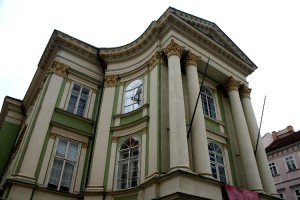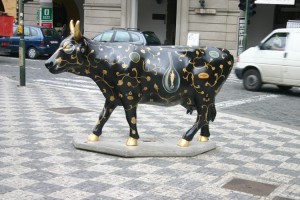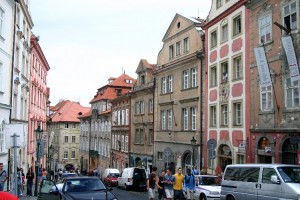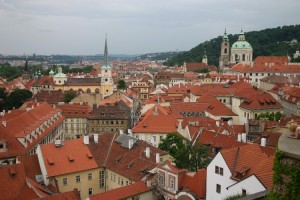Prague is completely and absolutely full of tourists of every stripe-
German, Italian, Japanese, English, and American. The entire old city of Praha – which is made up of 5 historic precincts, the Old Town, the New Town (about 700 years old, not so new), the Jewish Quarter, then cross the river to the Little Town and Prague Castle – seems to have its mindset on selling something to the tourists all looking for things to do in Prague. We see little evidence of stores catering to locals, although as we wend our way around these ancient areas, we are surprised that many of the people who sit in the outdoor cafés are speaking Czech.
Music for Sale
The number one item on the sales agenda is music – there must be a different concert in a different venue on a different night for every tourist. We can’t get over how many flyers we are handed and posters we see for different concerts, catering to all musical tastes from the greatest hits of the 1500s to concerts of musical theatre. And I will always remember Prague as the city of music because trios and quartets play and sing for coins on the streets and bridges – all of them surprisingly good. We can’t help but become infected with the spirit of this musical city, and as we walk we sing snatches from Don Giovanni, which Mozart premiered in Prague, and which is the #1 offering on the musical menu – from 3 full productions daily, one at the Estates Theatre, one at the Black Light Theatre, and one at the Marionette Theatre, to arias included on the programme of many of the concerts; Prague seems to thrive (at least economically) on this opera. This does not include the incredible number of hour-long “hits” concerts at the various churches and chapels of the city.
Helena Takes us on a Walking Tour
After a bite of lunch in one of those outdoor cafés, we join a 4-hour walking tour that promises to give us the full story on what to do in Prague. We start in Wenceslas Square, which we had explored yesterday. Our Prague guide, Helena, points out the bullet holes in the Museum at the top of the square, which dates from the Russian invasion of 1968, which stopped the democratic reforms known as the Prague Spring. The Russians mistook the museum for the Parliament, which is across the street and to the left. A few metres away are the monuments to two young men who both committed suicide by setting themselves on fire to protest the Russian actions. They were 19 and 20. We head from the New Town, started by Charles IV in 1348, through a narrow passage to the Old Town. By this action, Charles intended to make Prague the capital of the Holy Roman Empire, and the most modern city in Europe. Helena shows where the walls used to be and indicate the roof of the 1 gate still standing. Most of what Helena points out here we had stumbled across yesterday, but she does take us by the Estates Theatre, so-called because it was built for the exclusive use of the aristocracy, meaning that we common folk were not able to see Don Giovanni in its original production when it premiered here. The opera scenes of the movie Amadeus were filmed inside the theatre, and the production which plays every day all summer long uses historically appropriate costumes, scenery and staging techniques.
The Story of the Jews in Czech
Around the corner is the Jewish Quarter. We are realizing that these Towns, originally all legally separate entities are not very big geographically – we wonder how many people actually lived in each town 500 and 600 years ago. The story of the Jews in Czech is not a happy one – restricted from leaving the Quarter, prohibited from carrying out any activities except selling jewels and gold and lending money, enduring the occasional pogrom, but tolerated for much of the time because they provided the only source of capital (necessary to finance the king’s spending) at a time when the Church prohibited Christians from lending money. This changed in 1848, as part of the wave of social unrest that swept through Europe that year, when the Czech Jews were guaranteed their civil rights. By the beginning of WWII, there were about 18,000 Jews in Prague, and the Jewish Quarter had fallen into disrepair after a century in which they were able to live anywhere. By the end of the war, the Jewish population was gone, few of the survivors returned to Prague, and the synagogues, public buildings, and cemetery are all museums (and – as are almost all building in Prague – concert venues). There are only about 1,500 Jews living in Prague now.
On the Steps of the Palace
We cross the Charles Bridge into the Little Town, where the nobility lived following the construction of the bridge, the better to be close to the Castle. Nestled among the many palaces is St. Nicholas Church, not to be confused with St. Nicholas Church (another St. Nicholas Church, in the Old Town: one was built by the father, the other by his son, both Baroque – Helena speculates on the dynamics of this particular family). We walk up and up, rising to the Castle which dominates the City. This castle, still actively used – the President’s official residence, numerous ministries and museums, and the Cathedral, is in amazing shape. It is huge – according to one guidebook it is the largest unified castle complex in the world. We tour the Castle, marveling at this sight and that – in particular, St. Vitus’ Cathedral is quite fantastic. Helena tells us that this is the 1st building to use the particular style of vaulting in the roof, and that it spread from here to become quite common throughout Europe. This building was actually only completed in 1929; although it was started in 1344, only ½ was completed before the Hussite Wars interrupted construction, and possibly by the lack of money and interest in completion after the death of Charles the IV. Most fascinating in a macabre sort of way is the window out of which the good citizens of Prague, at this point converts to Protestantism, pitched 2 Catholic representatives of the Hapsburgs – the Hapsburgs were Catholic, and theirs was the official religion of the empire. This action, known as the 2nd Defenestration of Prague, started the 30 Year War in 1618, one of the most vicious wars in European history, a battle between Protestants and Catholics. And the good citizens of Prague ultimately reconverted to Catholicism, still the main religion in the Czech Republic.




















Comments
 Ryan Biddulph
Ryan Biddulph
AuthorHi Gregg,
What a gorgeous city rich with history. I met an expat in Thailand who lived in Prague for over a decade. He adored the city and had many stories to tell of his time there working in a university. This is on our list.
Ryan
 Gregory George
Gregory George
AuthorYeah! Love to return. Thanks for stopping by, Ryan! Always a pleasure!
 PragueByKaty
PragueByKaty
Author🙂
it is Habsburg family and in Charles the IV days Prague WAS (and was not INTENDED to be) the capital of Roman empiry and the seat of Roman Emperor
The building of the ST. Vitus cathedral was not stopped because of Hussites, but by the lack of the money and interest after the death of Charles the IV
the good citizens of Prague had to convert, otherwise they would lost all what they had, even lifes, but always their homes, money, family, work and lots of them left to Western Europe (Jan Amos Komensky – Comenius)
Catholicism IS the main religion, but Czech people are really secular, only about 40 % people say they are Christians and for 50% of them it is really only a word
 followsummergreg
followsummergreg
AuthorAgain, thank you for the historical clarification…